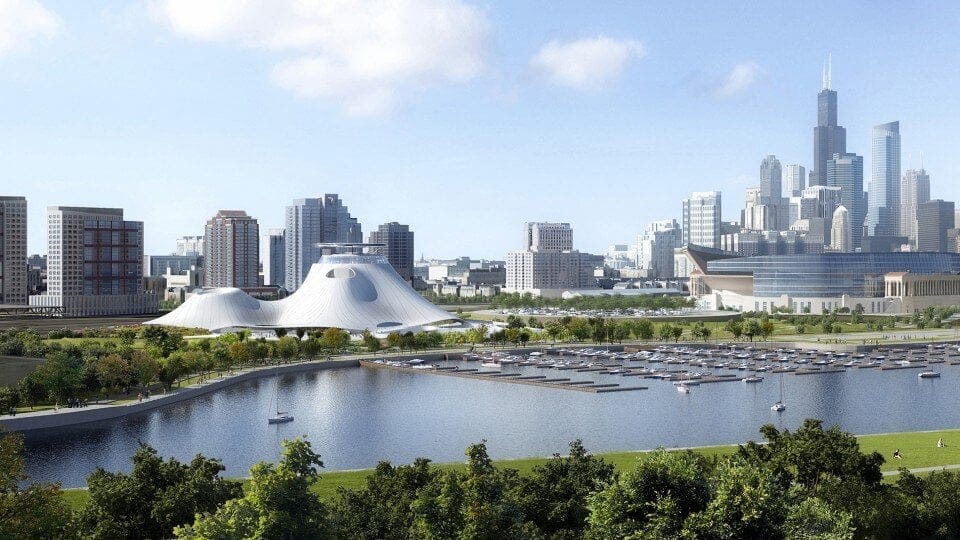
Lucas Museum of Narrative Art
Editor's note: This story was published in March 2016. In January 2017, museum representatives announced plans to construct the building in Los Angeles.
Editor's note: This story was published in March 2016. In January 2017, museum representatives announced plans to construct the building in Los Angeles.
by Judson Picco, Web Editor
The Lucas Museum of Narrative Art is a proposed museum in Chicago, planned to house a collection of paintings, photography, digital art, film props and other objects that tell stories through art. From Norman Rockwell paintings to “Star Wars” storyboards, the collection would be a significant addition to Chicago’s cultural scene.
THE PEOPLE
The first name associated with the museum is, of course, George Lucas, the creative force behind “Star Wars” and other household names like “Indiana Jones” and even Pixar (founded in 1979 as the Graphics Group, a division of Lucasfilm). A number of well-known architects are also involved in the project. Chinese architect Ma Yansong of MAD Architects is leading the design of the museum itself. This will be Ma’s first solo project in Chicago, but not his first in the region. MAD designed Toronto’s twisting Absolute Towers, which were completed in 2012. Chicago-based VOA is the architect of record. And Jeanne Gang’s firm, Studio Gang, is creating the landscape design alongside SCAPE Landscape Architects.
HISTORY OF THE MUSEUM CAMPUS
The Lucas Museum could have its own place in the long history of Chicago’s museum campus, which has only existed officially since the 1998 reconfiguration of Lake Shore Drive. The Field Museum got its “new” lakefront digs in 1921, though its origins reach back to the World’s Fair of 1893. It was founded just after the fair in Jackson Park’s Palace of Fine Arts—a building that’s now known as the Museum of Science and Industry. In 1930, Adler Planetarium opened on Northerly Island, the artificial peninsula completed in 1925 and originally envisioned by Daniel Burnham’s 1909 Plan of Chicago.
Also anticipated by the Burnham Plan, the 6-mile-long Burnham Park connects Grant Park to Jackson Park. It was named officially in 1927, by which time Holabird and Roche’s Soldier Field had been dedicated in honor of U.S. troops killed in combat. In 1930, Shedd Aquarium joined the Field Museum as the second Graham, Anderson, Probst & White building in Burnham Park. Those two, as well as Adler Planetarium, got starring roles near the site of the 1933–1934 Century of Progress World’s Fair. The picturesque collection of cultural institutions and a 74,000-seat sports facility were joined in 1960 by McCormick Place, still the largest convention center in North America.
THE SITE
As of March 2016, the Lucas Museum’s proposed site is on the lakefront in the museum campus. The site is between Soldier Field and McCormick Place. Currently, there are two large parking lots between these two structures. The larger South Lot is set to be replaced by the Lucas Museum and its surrounding landscape.
The location of the proposed museum has caused some controversy. The city has approved the project, but its future depends on the results of a federal lawsuit from the open-spaces advocacy group Friends of the Parks. The lawsuit claims that the site is held in the public trust because it was formerly part of Lake Michigan and that the land should be protected and preserved for the state's residents.
THE DESIGN
The interior of the Lucas Museum would combine gallery, theater and education spaces. Inside, three screening rooms in a flower-petal pattern sit side-by-side with the building’s rounded gallery spaces under a skylit atrium. For views of Lake Michigan, an open-air observation deck is planned for the conical, 150-foot top of the museum.
Then there’s Ma Yansong’s much-discussed exterior. Organic-looking and computer-modeled, the curvy structure has been compared to everything from a lakeside sand dune to a certain hefty “Star Wars” villain. As the museum’s website puts it, the “path of visitor travel and the extraordinary shape of the building and its materials” hope to inspire stories themselves.
WHAT’S NEXT?
Some estimates predict that the Lucas Museum will attract as many as 1 million visitors annually. Such crowds would pose a serious challenge to the already complicated museum campus public transit picture. As far back as October 2014, groups including Chicago Streetcar Renaissance have been proposing ideas to improve area transit. They envision the “Superloop” as a streetcar line that would link every museum campus stop, via downtown, to Navy Pier.
In March 2016, construction on the Lucas Museum was on hold due to the above-mentioned lawsuit. Should the museum clear that hurdle, it is expected to open in 2019 or 2020. Whatever is next, CAC will follow the story and update you on how it impacts Chicago’s landscape and architecture.
